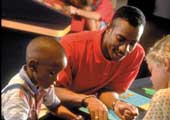The Evolution of Education
In October 1957 the Soviet Union launched into orbit of Sputnik, the first-ever artificial satellite. The Russian achievement served as a wake-up call for Americans who realized they needed to improve U.S. science and math education to compete in a science- and technology-driven world. The space race was on, and only a highly educated group of homegrown scientists and engineers could get Americans to the moon ahead of the Russians. For the first time, education in the United States became a major federal imperative.
The government, perceiving a national crisis, turned to the young National Science Foundation, which had established strong ties to the country's research universities. With the National Defense Education Act of 1958, Congress called upon NSF to attend to kindergarten through twelfth-grade (K-12) education in mathematics and science. Later, Congress explicitly added social studies to the mandate.

Over the next twenty years, NSF spent $500 million on elementary and secondary school curricula and teacher development. Teams of scientists, educators, and teachers worked together to develop new curricula in physics, biology, chemistry, and mathematics. At the same time, universities held hundreds of summer programs to assist teachers in understanding and using the new materials.
Two aspects of the new curricula distinguished them from their predecessors. First, there was an emphasis on basic principles. How do waves form? What keeps molecules from flying apart? What are functions? Second, there was an assumption that students would best learn basic scientific principles by actually performing experiments rather than simply memorizing facts.
In a 1977 survey, NSF found that forty-one percent of the nation's secondary schools were using at least one form of the science curricula developed with NSF funds. In contrast, fewer than ten percent of schools were using NSF-funded math materials, which many found confusing. Despite the partial success, Congress reined in much of the NSF curriculum effort by the late 1970s. Lawmakers' objections to a new social science curriculum and a general lack of enthusiasm for major changes in education were largely to blame. The decline continued in the early 1980s when the administration's goal of a smaller federal government resulted in budget cuts that hit NSF's education programs particularly hard.
But then the tide turned again. In 1983, a federally commissioned report entitled A Nation at Risk warned of "a rising tide of mediocrity" in the nation's schools that was serving to erode America's leadership in the world economy. The report triggered fresh calls for the setting of national or at least state-level education standards and sent NSF back into the K-12 education arena with renewed vigor.
|
